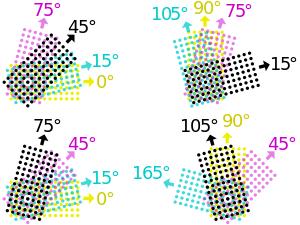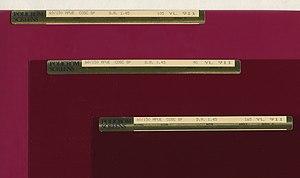In offset printing, the screen angle is the angle at which the halftones of a separated color is made output to a lithographic film, hence, printed on final product media.
Motivation
In offset printing, colors are output on separate lithographic plates. Failing to use the correct set of angles to output every color may lead to a sort of optical noise called a moiré pattern which may appear as bands or waves in the final print. There is another disadvantage associated with incorrect sets of angle values, as the colors will look dimmer due to overlapping.
Typical values
While the angles depend on how many colors are used and the preference of the press operator, typical CMYK process printing uses any of the following screen angles:[1][2]
| C | 15° | 15° | 105° | 165° |
|---|---|---|---|---|
| M | 75° | 45° | 75° | 45° |
| Y | 0° | 0° | 90° | 90° |
| K | 45° | 75° | 15° | 105° |

